李月舟课题组在《Nano Letters》发表文章开拓超声在脑科学研究中的新方向
近日,浙江大学医学院李月舟课题组和中科院深圳先进研究院郑海荣课题组合作在Nano Letters期刊发表了题为Ultrasonic control of neural activity through activation of mechanosensitive channel MscL的研究论文(图1)。该项研究将超声辐射力和机械敏感性离子通道结合起来,首次在神经元上通过超声刺激激活机械敏感性离子通道,并进而精确控制神经元的兴奋性。该成果开拓了超声在脑科学研究中的新方向,为超声遗传学技术的进一步发展奠定了基础,具有重要的理论意义和应用价值。

图1: 超声刺激引起表达于神经元的机械敏感性离子通道MscL(图中黄色所示)的开放,导致离子跨膜运输(图中绿色箭头所示),改变神经元膜电位,诱发神经冲动(图中红色所示动作电位)。
美国科学院院士, 麻省理工学院Robert Desimone教授对此工作进行了点评:
The development of methods to use light to control the firing of neurons in the brain has revolutionized neuroscience research. But light based methods generally require a probe implanted in the brain to deliver the light. If one could use a noninvasive source of energy, such as ultrasound, to control neurons, this would have major research and clinical applications. The results of Jia Ye et al with ultrasound look extremely promising, and I am sure they will stimulate more research to test the use of ultrasound in many neural applications, both basic and clinical.
浙江大学医学院的博士生叶佳、唐思阳,以及深圳先进研究院的孟龙副研究员,是本文的第一作者。郑海荣和李月舟是本文的通讯作者。参与该工作的还有浙江大学医学院的段树民院士、胡海岚教授、李相尧教授,浙江大学附属儿童医院的舒强院长、江米足教授、尚世强教授,深圳先进研究院的牛丽丽副研究员、邱维宝研究员。该研究得到国家自然科学基金(81527901,11534013,31270878)、科技部973计划(2014CB910302)等项目的资助。


